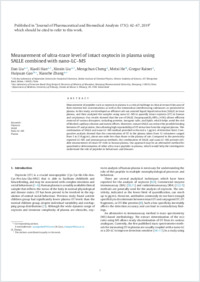Measurement of ultra-trace level of intact oxytocin in plasma using SALLE combined with nano-LC–MS
- Liu, Dan CAS Key Laboratory of Separation Sciences for Analytical Chemistry, Dalian Institute of Chemical Physics, Chinese Academy of Sciences, Dalian, China
- Han, Xiaoli CAS Key Laboratory of Separation Sciences for Analytical Chemistry, Dalian Institute of Chemical Physics, Chinese Academy of Sciences, Dalian, China
- Liu, Xinxin CAS Key Laboratory of Separation Sciences for Analytical Chemistry, Dalian Institute of Chemical Physics, Chinese Academy of Sciences, Dalian, China
- Cheng, Mengchun CAS Key Laboratory of Separation Sciences for Analytical Chemistry, Dalian Institute of Chemical Physics, Chinese Academy of Sciences, Dalian, China
- He, Meixi Key Laboratory of Structure-Based Drug Design and Discovery of Ministry of Education, Shenyang Pharmaceutical University, China
- Rainer, Gregor Department of Medicine, University of Fribourg, Switzerland
- Gao, Huiyuan Key Laboratory of Structure-Based Drug Design and Discovery of Ministry of Education, Shenyang Pharmaceutical University, China
- Zhang, Xiaozhe CAS Key Laboratory of Separation Sciences for Analytical Chemistry, Dalian Institute of Chemical Physics, Chinese Academy of Sciences, Dalian, China
-
2019
Published in:
- Journal of Pharmaceutical and Biomedical Analysis. - 2019, vol. 173, p. 62–67
English
Measurement of peptides such as oxytocin in plasma is a critical challenge in clinical research because of their extreme low concentrations as well as the tremendous interferencing substances co-presented in plasma. In this study, we developed an efficient salt-out assisted liquid-liquid extraction (SALLE) to treat plasma, and then analyzed the samples using nano-LC–MS to quantify intact oxytocin (OT) in human and rat plasmas. Our results showed that the use of SALLE (Isopropanol/K2HPO4 (4 M)) allows efficient removal of various disrupters, including proteins, inorganic salts, and lipids, which helps avoid the risk of blocked capillary columns and matrix effects. Moreover, instant SALLE can reduce the possible binding between OT and proteins, thus allowing high repeatability of OT extraction from the original plasma. This combination of SALLE and nano-LC–MS method provided in the end a 1 pg/m L of detection limit. Comparative analysis showed that the concentration of OT in the plasma taken from 12 volunteers ranged from 3 to 214 pg/m L, about one order less than those in the plasma of rats. Compared to the previously reported LC–MS and immunoassay methods, the combination of SALLE and nano-LC–MS permits reliable measurement of intact OT even in human plasma. Our approach may be an alternative method for quantitative determination of other ultra-trace peptides in plasma, which would help the investigators understand the role of peptides in behaviours and diseases.
- Faculty
- Faculté des sciences et de médecine
- Department
- Département de Médecine
- Language
-
- English
- Classification
- Biological sciences
- License
-
License undefined
- Identifiers
-
- RERO DOC 326979
- DOI 10.1016/j.jpba.2019.04.023
- Persistent URL
- https://folia.unifr.ch/unifr/documents/308141
Other files
Statistics
Document views: 105
File downloads:
- pdf: 445
- Supplementary material: 141

